
|
Note ye ed's email address: stevebryant99@gmail.com. |


A surprising new photo album.
|
In case you missed it, check out February's Magi-fest issue. Josh and Andi and Tim Moore threw the first great party of the year. |
April 2014 Happy April Fool's Day, all month long. As fooling is the primary activity in magicdom, I am running a list below of things that have fooled me badly over the years. Also of interest: a funny British sitcom, Tamariz fooling Magi-festers on a Friday night, a confab with Todd Karr, and a fabulous photo album featuring playing cards. Meanwhile, from California, the Magic Castle's esteemed prez Neil Patrick Harris is taking his talents to New York City (to paraphrase Lebron James), which leaves a significant opening to be filled by none other than Erika Larsen. Congratulations to Erika, and we wish her all the best. I can just imagine the timbers of the old house flexing in satisfaction, happy to have a Larsen as prez once again. All's right with the world. |
|
|
A FOOL SUCH AS I -- Ah, secrets. Although the method to the Hooker Rising Cards is one of the most closely guarded secrets in magic, it isn't the only secret in magic, at least not from me. Numerous magic tricks fooled me the first time I saw them and continue to fool me today. In honor of this April Fool's edition of Little Egypt Magic, let's list a few of the most prominent candidates: | |
|
Bizzaro's Silk Through Hand. I fell in love with this the first time I saw Bizzaro do it. Yeah, I kinda know what's going on, but I certainly don't know the specifics, nor would it be my privilege to perform it if I did. It's high on my wish list for Bizzaro to release this some day, at a hefty fee. But for his sake I don't think he should. Ever. |
 Bizzaro freaks out Amazing Johnathan. |
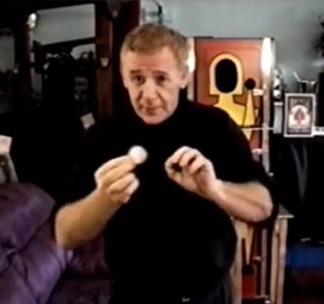 Mickey about to vanish a coin, repeatedly. |
Mickey Silver's Retention Vanish. This retention vanish of a coin looks so good that Mickey can repeat it for an hour (and often does!) without anyone being the wiser. Mickey has hinted that he will release it some day, but so far I still have no clue. You can watch Mickey do it yourself on YouTube here. By the way, if you are interested in a (Rub-a-Dub) card vanish that looks equally good, check out Glenn Morphew's version at Vanishing, Inc. |
|
Origami. Yes, Origami. Jim Steinmeyer's folded up girl illusion looked great the first time I saw Doug Henning do it and continues to look great in the hands of others. Sure, most of us think the girl is hiding somewhere in the base. But that mirror -- shown here in Jim's patent application (for the "ornamental design" of an "illusion device") -- has always puzzled me. Is it merely an artistic touch, is it a red herring, or is it part of the method? |
 Origami patent sketch. |
|
Astarte. I didn't even know that the levitation Astarte existed (much less its method) until it was performed at the last Los Angeles Conference on Magic History and subsequently written up in Genii, complete with video. The girl spins vertically, horizontally, and somersaults through a hoop. Now I am aching to know how it's done. Regarding other little known levitations, I'd have been equally amazed by those described in Jim Steinmeyer's book, Technique & Understanding.  Astarte. | |
|
 There's no way these suckers can move. |
Michael Weber's Nail Matrix. Michael Weber can fool me with everything he does. His Nail Matrix remains my favorite: Michael taps several nails into a board with a hammer so that they stand upright, and then he covers each with a styrofoam cup. Beneath the cups, the nails magically migrate to different postions on the board, a la Sympathetic Coins or Matrix. You can catch a snippet of the routine on Ricky Jay's current documentary, Deceptive Practice. (You can also catch a snippet of Michael performing a pass--but you won't see anything!) |
|
Armando Lucero's Coin Menagerie. Speaking of Matrix, there are many beautiful versions, and I've enjoyed those in the hands of Chris Kenner, Eric Mead, John Kennedy, and David Roth, among others. But the killer when it comes to fooling people is Armando's Coin Menagerie with its eye-popping transpositions. This one does not have to be a secret: Armando occasionally teaches it for a fee, but so far I haven't justified the considerable sum it takes to attend his workshop. At least I have enjoyed the thrill of seeing it live. |
 Sympathetic Coins as art. |
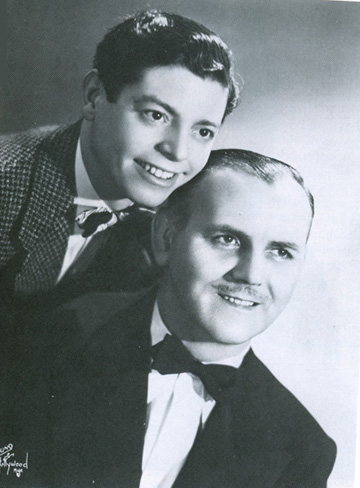 Eddie Fields and George Martz. |
Eddie Fields' Mind-Reading Code. Eddie's bio, A Life Among Secrets, by Stephen Minch, reveals much about this two-person code act, which allowed Eddie and his partner George Martz to code first and last names, questions, and objects, with Eddie seeming to be invisible as a blindfolded George revealed the information. I never saw Eddie do the code act, but have seen others do most effective variants, including Brian Gillis, Danny Orleans, and Simon Aronson and their partners. According to his recent Genii cover story, Simon may tip his some day, so there is hope. Along the way, I have attempted similar routines only twice, once with a simple card code, and once with an outright bluff, Simon Lovell's Double Trouble. The latter was great fun to do. (There is a fine card code in Steinmeyer's The Magic of Alan Wakeling.) |
|
Bill Larsen's Comedy Code Act. I saw Bill and Princess Irene perform this in the Haunted Wine Cellar stage in the early days of the Magic Castle, and it was grandly entertaining. You know the idea: Bill: "What is this? Take your time." Princess: "A watch." Bill: "What is on this lady's neck?" Princess: "Her boyfriend's arm." But, with different and much funnier gags. At one point Bill said he was going to perform it once more and then would publish the routine in Genii. Sadly, that never happened. I'd love to see it published, or perhaps performed one day (by Erika?), just to relive the performance. Other such acts are in the literature. One is Abba Dabba the Mystic, by Syl Reilly. The individual gags are pretty lame, but I like its structure, with gag questions first, then articles, then numbers. |
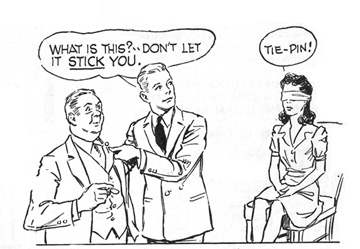 Bill and Princess Irene were the best. |
 Chris Kenner has the ultimate method. |
Kenner's Last Coin. There have been many versions of Three Fly, some purely sleight of hand, some with spendy gimmicks, but none makes the last coin evaporate as cleanly as Chris Kenner's. I'd love to know how he does it. I had the pleasure of seeing Chris do the routine in a trade show here in Indiana, before he hooked up with the Copperfield show. (By the way, if you subscribe to Kozmo's reel magic magazine, you get access to all the back issues, including my favorite, the Chris Kenner issue. Well worth your five bucks a month.) |
|
The Trick That Cannot Be Explained. The ultimate card trick? Vernon wrote it up, many have tried it, and Eugene Burger has absolutely mastered it. I'd love to be privy to Eugene's thinking behind it. He has occasionally taught the routine in seminars, but not, alas, in my vicinity. Perhaps some day. I have enjoyed performing a couple of routines that require similar think-on-your-feet endings, one being Nick Trost's Significator Cards (Subtle Card Creations Volume 3), the other being Marlo's Unexpected Prediction (Malone Meets Marlo DVDs). Fun magic! |
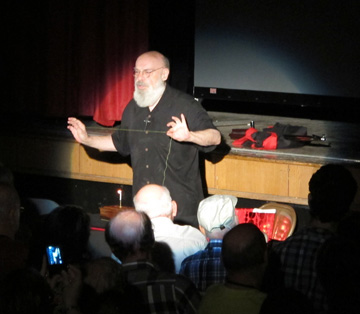 Eugene thinks on his feet. |
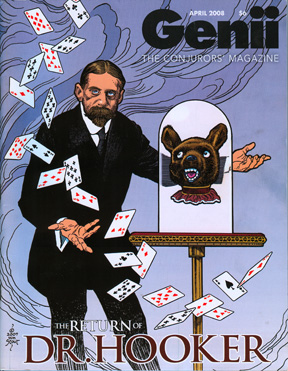 Cover story. |
The Hooker Rising Cards. Just because it was the seminal example, we shouldn't leave the Hooker Rising Cards off the list. Chemist and magician Dr. Samuel Hooker created, in his fifties, an entire act that featured rising cards and a rising teddy bear head. Complete descriptions appeared in Greater Magic, in Pallbearers Review, and in an April 2008 Genii cover story (based in part on 1993 and 2007 performances by John Gaughan). It must have been lovely to see, and I take some satisfaction in knowing that I am not alone in being ignorant of Dr. Hooker's secret. Over the years I've purchased many rising card effects--an oddball favorite is the Dick Zimmerman clear plastic houlette--and now consider that two of my collection would have fooled me had I not bought them: the Gary Plants Rising Cards and the Upton-Smith Rising Cards. |
|
Enough already. The above list barely scratches the surface. I'd love to chat with Kuda Bux about how he saw through that blindfold. I'd love to read a copy of Steranko's The Ultimate Move. I recently watched Juan Tamariz perform both informally and formally, and virtually everything he did fooled me, and I have his books. There remains so much to learn in magic, and therein lies part of its charm and continuing allure. I'm sure you have your own lists. Have fun with them, and good luck. | |
|
|
CHANNEL FOUR FOOLERY -- A tweet from Eric Mead alerted me to a really funny (and magically related) bit on a British sitcom. The sitcom is "The IT Crowd," which ran for four seasons of six episodes beginning in 2006. There was a final episode in 2013. Anyway, Eric's bit was from Series 3 Episode 2, and it cracked me up. I have been accused by my lay friends of acting like the guy in the clip. Click on the link and enjoy. (Even better: if you want to enjoy more of "The IT Crowd," the entire series is currently streaming on Netflix.)  The IT Crowd. |
|
|
FRIDAY NIGHT FOOLERY -- As mentioned elsewhere, I loved being fooled by Juan Tamariz at Magi-fest, my favorite moments being at his impromptu performance on late Thursday night. Juan also appeared in the wee hours of Friday night, and the clips below show he was equally adept that night at riveting attention and earning applause. Thanks again to Josh and Andi and Tim for a great weekend.  Tamariz totally controls attention. 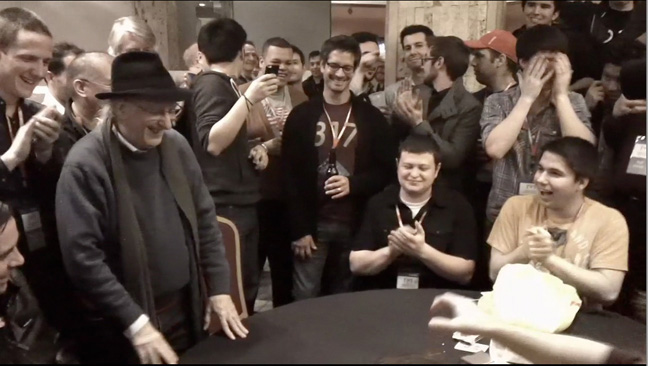 Tamariz stands to accept applause. |
|
|
FACTORY FOOLERY -- As readers know, I'm a big fan of Fitzgerld's Who's Hoo, his internet video show filmed at the Magic Castle. A recent sterling episode was his interview with Todd Karr, CEO of The Miracle Factory. Todd has long been one of my favorite guys in magic, his body of published hardbacks earning a most revered spot on my magic book shelves. The interview covered Todd's stint as a writer for the L.A. Times Calendar section, his eight years as a professional magician in France, his publication record, his niche as a producer of vintage video and audio, his role as an entertainment director at the Magic Castle, his work as a tv consultant, and his future plans, among other things. The future plans include at least one that may help satisfy my bucket list of secrets above, and Todd also promises more epic books. His goal, to quote him, was to hit each book out of the park, and, so far as my purchases attest, he's batting one thousand. 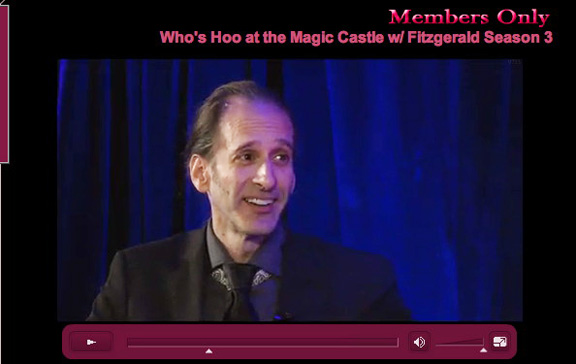 Todd Karr chats with Fitzgerald. |
|
|
PHOTO FOOLERY -- The new book Playing Cards in Photographs, by antique dealer Laurence H. Lubliner, edited in part by Gabe Fajuri and published by Squash Publishing, came as a delightful surprise. From its title and ad copy I expected a nice collection of vintage photos depicting folks playing cards. I did not expect such fascinating accompanying text or such richness in detail in the photos themselves. I learned a lot about about playing card history, playing card manufacturers, card games, card costumes, cards in twentieth-century wars, and photography itself. Games depicted include Faro, Texas Holdem, Seven-Card Stud, Draw Poker, Euchre, Cribbage, Skat, Uta-Garuta, Seven Up, Solitaire, Concentration, and Tripoli, among others. Playing these games were families, moonshiners, hobos, children, cheaters, blind strikers, sighted strikers, street gangs, a Dutch soccer team, lesbians, a fortune teller, the physically handicapped, a dog, Asian women, five naked guys, magicians, soldiers, sailors, POWs, woodsmen, and guys in gas masks. Many others dressed up in card costumes. Celebrities with pasteboards included Doyle Brunson, Rocky Marciano, Yogi Berra, Phil Rizzuto, Brian Berg (champion card stacker), Ronald Colman, Bob Hope, Barbara Stanwyk (lovers of cards should be huge fans of her movie The Lady Eve), and magicians Dante and Dai Vernon with Johnny Paul. 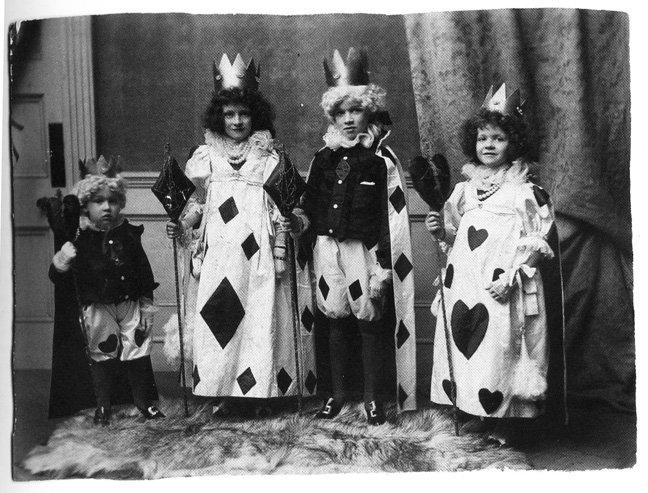 How magicians make their kids dress? As the above suggests, there is plenty to delight both the eye and the mind of anyone interested in cards. I grew up around cards--my grandmothers and great aunts all played and hosted card parties while the men played at fraternal organizations--yet I have almost no photos of my relatives in action. It's nice to see that other card games were not so undocumented. This is a big square hardback book--imagine a record album, if you remember them-- of 92 pages on glossy stock. Text in black provides background information on card history, while text in red provides entertaining commentary on the individual photos. All in all a grand project, and I hope Mr. Lubliner comes across enough new photos for a second volume. Magicana is currently offering a discounted signed copy through April 11. I got mine from H&R Magic Books. $35. |
 You look mah-velous.
Re-read a magic book from your childhood.
Little Egypt Magic is the erratically updated web site of Steve Bryant, spawned (the site, not Steve) by a former internet magazine known as The Little Egypt Gazette/for magicians only. Steve Bryant is an obscure magician and writer who generates this site from an iMac in Bloomington, Indiana. He used to frequently journey to and perform magic in Little Egypt, the local name for extreme southern Illinois, where the towns bear such names as Cairo, Thebes, and Karnak. Past issues of this web site: Index to Past Issues Notice: Any limited use of copyrighted images or quoted text is considered fair use, usually to review whatever product or event that is under discussion. If you object to use of any material, please get in touch and it will be cheerfully removed. |
A JSB Creations product
Copyright© 2014 by Steve Bryant